ABCA1-Derived Nascent High-Density Lipoprotein-Apolipoprotein AI and Lipids Metabolically Segregate
- PMID: 29074589
- PMCID: PMC5831354
- DOI: 10.1161/ATVBAHA.117.310290
ABCA1-Derived Nascent High-Density Lipoprotein-Apolipoprotein AI and Lipids Metabolically Segregate
Abstract
Objective: Reverse cholesterol transport comprises cholesterol efflux from ABCA1-expressing macrophages to apolipoprotein (apo) AI, giving nascent high-density lipoprotein (nHDL), esterification of nHDL-free cholesterol (FC), selective hepatic extraction of HDL lipids, and hepatic conversion of HDL cholesterol to bile salts, which are excreted. We tested this model by identifying the fates of nHDL-[3H]FC, [14C] phospholipid (PL), and [125I]apo AI in serum in vitro and in vivo.
Approach and results: During in vitro incubation of human serum, nHDL-[3H]FC and [14C]PL rapidly transfer to HDL and low-density lipoproteins (t1/2=2-7 minutes), whereas nHDL-[125I]apo AI transfers solely to HDL (t1/2<10 minutes) and to the lipid-free form (t1/2>480 minutes). After injection into mice, nHDL-[3H]FC and [14C]PL rapidly transfer to liver (t1/2=≈2-3 minutes), whereas apo AI clears with t1/2=≈460 minutes. The plasma nHDL-[3H]FC esterification rate is slow (0.46%/h) compared with hepatic uptake. PL transfer protein enhances nHDL-[14C]PL but not nHDL-[3H]FC transfer to cultured Huh7 hepatocytes.
Conclusions: nHDL-FC, PL, and apo AI enter different pathways in vivo. Most nHDL-[3H]FC and [14C]PL are rapidly extracted by the liver via SR-B1 (scavenger receptor class B member 1) and spontaneous transfer; hepatic PL uptake is promoted by PL transfer protein. nHDL-[125I]apo AI transfers to HDL and to the lipid-free form that can be recycled to nHDL formation. Cholesterol esterification by lecithin:cholesterol acyltransferase is a minor process in nHDL metabolism. These findings could guide the design of therapies that better mobilize peripheral tissue-FC to hepatic disposal.
Keywords: apolipoprotein AI; atherogenesis; cholesterol; lipids; lipoprotein.
© 2017 American Heart Association, Inc.
Figures

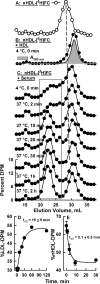
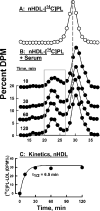
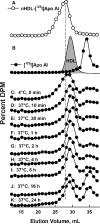

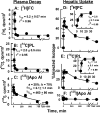

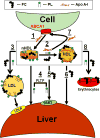
Similar articles
-
Nascent HDL (High-Density Lipoprotein) Discs Carry Cholesterol to HDL Spheres: Effects of HDL Particle Remodeling on Cholesterol Efflux.Arterioscler Thromb Vasc Biol. 2020 May;40(5):1182-1194. doi: 10.1161/ATVBAHA.120.313906. Epub 2020 Mar 5. Arterioscler Thromb Vasc Biol. 2020. PMID: 32131613 Free PMC article.
-
Revisiting Reverse Cholesterol Transport in the Context of High-Density Lipoprotein Free Cholesterol Bioavailability.Methodist Debakey Cardiovasc J. 2019 Jan-Mar;15(1):47-54. doi: 10.14797/mdcj-15-1-47. Methodist Debakey Cardiovasc J. 2019. PMID: 31049149 Free PMC article. Review.
-
Rethinking reverse cholesterol transport and dysfunctional high-density lipoproteins.J Clin Lipidol. 2018 Jul-Aug;12(4):849-856. doi: 10.1016/j.jacl.2018.04.001. Epub 2018 Apr 12. J Clin Lipidol. 2018. PMID: 29731282 Free PMC article. Review.
-
Novel Apo E-Derived ABCA1 Agonist Peptide (CS-6253) Promotes Reverse Cholesterol Transport and Induces Formation of preβ-1 HDL In Vitro.PLoS One. 2015 Jul 24;10(7):e0131997. doi: 10.1371/journal.pone.0131997. eCollection 2015. PLoS One. 2015. PMID: 26207756 Free PMC article.
-
The origin and metabolism of a nascent pre-β high density lipoprotein involved in cellular cholesterol efflux.Acta Biochim Pol. 2011;58(3):275-85. Epub 2011 Jul 12. Acta Biochim Pol. 2011. PMID: 21750785 Review.
Cited by
-
Cholesterol transport between red blood cells and lipoproteins contributes to cholesterol metabolism in blood.J Lipid Res. 2020 Dec;61(12):1577-1588. doi: 10.1194/jlr.RA120000635. Epub 2020 Sep 9. J Lipid Res. 2020. PMID: 32907987 Free PMC article.
-
Different Pathways of Cellular Cholesterol Efflux.Cell Biochem Biophys. 2022 Sep;80(3):471-481. doi: 10.1007/s12013-022-01081-5. Epub 2022 Jun 23. Cell Biochem Biophys. 2022. PMID: 35737216 Review.
-
Common Genetic Variations Involved in the Inter-Individual Variability of Circulating Cholesterol Concentrations in Response to Diets: A Narrative Review of Recent Evidence.Nutrients. 2021 Feb 22;13(2):695. doi: 10.3390/nu13020695. Nutrients. 2021. PMID: 33671529 Free PMC article. Review.
-
High Free Cholesterol Bioavailability Drives the Tissue Pathologies in Scarb1-/- Mice.Arterioscler Thromb Vasc Biol. 2021 Oct;41(10):e453-e467. doi: 10.1161/ATVBAHA.121.316535. Epub 2021 Aug 12. Arterioscler Thromb Vasc Biol. 2021. PMID: 34380332 Free PMC article.
-
Cholesterol: Can't Live With It, Can't Live Without It.Methodist Debakey Cardiovasc J. 2019 Jan-Mar;15(1):9-15. doi: 10.14797/mdcj-15-1-9. Methodist Debakey Cardiovasc J. 2019. PMID: 31049144 Free PMC article. Review.
References
-
- Lacko AG, Pritchard PH. International Symposium on Reverse Cholesterol Transport. Report on a meeting. J Lipid Res. 1990;31:2295–2299. - PubMed
-
- Toth PP, Barter PJ, Rosenson RS, et al. High-density lipoproteins: a consensus statement from the National Lipid Association. Journal of clinical lipidology. 2013;7:484–525. - PubMed
Publication types
MeSH terms
Substances
Grants and funding
LinkOut - more resources
Full Text Sources
Other Literature Sources
Medical
Molecular Biology Databases
Research Materials
Miscellaneous

